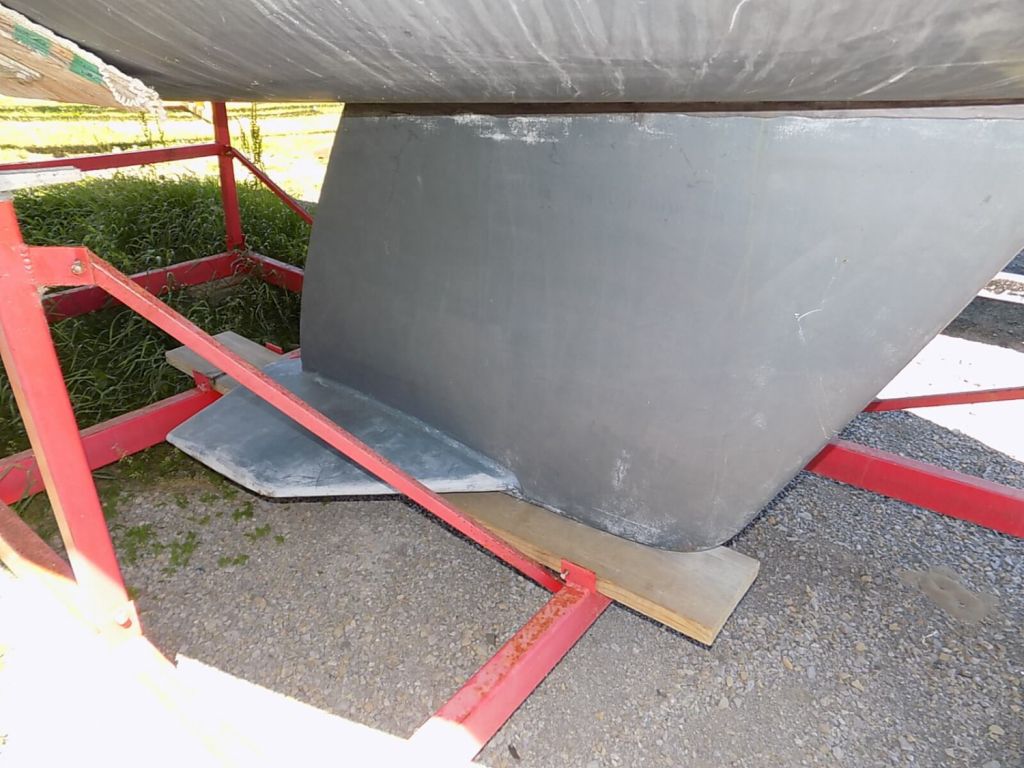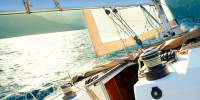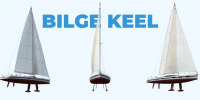Pros and Cons of the Wing Keel (5 Surprising Benefits)
Wing keels are a popular choice for many sailors and are offered as an option when buying a new one. Let's explore its pros and cons so that you know what to choose based on your specific needs.
What are the pros of the wing keel? Thanks to its wide horizontal fin, the wing keel has a shallower draft than a regular fin keel. This provides better clearance, allowing you to sail in shallower waters. It also provides a lower center of gravity than other keel designs. The design is especially useful when sailing lakes, since water levels are getting lower.
What are the cons of the wing keel? The wing keel design can't point as sharp windward; you will generally loose 5 degrees. It will create higher drag, offering worse performance overall compared to the fin keel. Since wing keels are shorter, its rudders sometimes need to be shorter as well, to protect them from hitting the seafloor.
Let's look at this in more detail so that you know which type of keel suits you personally.

On this page:
Pros and Cons of the Wing Keel
Wing keels come in all shapes and sizes but the general idea is to have, aside from the vertical fin of the traditional keel, a horizontal foil on the bottom.
The idea for a wing keel came about during of one of the America Cup races. It was introduced to increase performance by reducing leeway when a boat heels and helping the water flow over the bottom. In practice though, the reason for its popularity is because of its shallow draft, not performance.
What are the pros and cons of the wing keel?
| Advantages | Disadvantages |
|---|---|
| Shallow draft | Can't point as sharp windward |
| Lower center of gravity | Worse performance overall |
| Better access during maintenance | Whorter rudders - worse handling |
| Stiffer ride | Difficulty getting unstuck when aground |
| Innovation |
Advantages of the Wing Keel
Shallow draft
The main reason the wing keel gained popularity is that it offers better clearance. The horizontal wing enlarges the keel's surface area and so it doesn't have to go as deep as a fin keel on a boat of the same size has to - the difference can easily be a foot of draft on a twenty-foot sailboat. This is quite irrelevant in the Mediterranean or Adriatic for the most part, also, ocean crossing boats don't have to care, but in the United States, especially around Florida for instance, this can make a difference.
Also, people who sail on lakes might find this useful, especially in this day and age, when quite a few lakes experience lower water levels than, say, twenty years ago. So if exploring shallow coastal waters is something you do, if you find yourself often on lakes, rivers or waterways without much depth, join the gang.
Lower center of gravity
Now this one sounds good but it isn't as black and white as you might wish for - more on that in a bit. Generally, since there is more mass on the lowest point of the keel, you will likely have a lower center of gravity, which adds to stability.
You might experience less heeling, which is favorable for performance and comfort for those who get nervous when the railing touches the water. The boat will also rock less, which is something the seasick ones will welcome as well as anybody who uses open liquid containers on the boat - whether that be somebody wanting to enjoy a full cup of coffee or somebody looking to cook some pasta.
Now to relativize this point slightly - it is only valid when comparing boats with equally deep keels. But if you are comparing equally sized boats, one with a fin keel and one with a wing keel, the drafts simply won't be the same. So all in all it isn't a fair comparison since it would only apply for boats of different sizes.
Maintenance access
The ease of access when maintaining a boat isn't really what people look at when choosing a boat. But it is a relevant point nonetheless. You see, when hauled, given the shallower draft, your boat will be lower to the ground, thus easier to access when you want to clean it from the pesky sea fauna and flora, repair it or apply some antifouling paint. Or do any work on its bottom in general.
Whether this one is beneficial for you depends on the kind of equipment you have at your disposal for these kinds of situations. If wooden crates and ladders are what you are using, you will probably welcome having your boat a few feet closer to the ground. If on the other hand, you have some kind of a motorized construction platform, you probably won't care as much.
Stiff ride
Because of the construction design as well as some of the benefits listed above, the ride with a wing keel is a bit stiffer than with the fin keel. Many sailors prefer this, especially the cruiser types, who will appreciate the reassuring ride. If comfort is your goal, or if it is a liveaboard you are looking to purchase, this might be a relevant factor for you.
Support of invention
Wing keel was developed in the pursuit of bettering the boating experience. Whether that worked or not, the important thing here is that somebody took a long-standing design that worked for centuries and decided to improve it. Not with a hi-tech feature, taking advantage of the technological progress, but rather with an idea that is structurally relatively simple. That is a bold move, which should be rewarded because its encouragement can lead to other, similar feats.
So by purchasing a wing-keel boat , you are showing support to improvement and fighting design dogmas that can be great and working, but as any dogma, they should be tested from time to time.

Disadvantages of the Wing Keel
Now it is the time for the disadvantages of wing keels - and not to discourage anybody ahead of time, but there are many. So wing keel supporters, brace yourselves.
Worse performance windward
No way around it. Simple fin keels have better performance windward. Choosing a wing keel will rob you of some 5 degrees since you just won't be able to point as high as you could with a fin keel. Now if you are on a cruiser or a liveaboard, where it is about the enjoyment of the ride rather than being able to go the optimal route, you don't have to care. But if this is a matter for you, think twice before going the wing route.
Worse performance all around
To make matters even a bit worse, a fin keel boat can point better, because of the larger vertical board area it tracks better, and, as will be explained later, sometimes has a larger rudder. Then there is drag - a wing keel will have higher drag than an equally deep fin keel, again, hindering the performance. So with wings, you can expect worse performance on many fronts.
Now, just as was the case with the previous point, this is something many won't care about, because performance isn't what they are in this for, or perhaps it's that the advantages outweigh the disadvantages. After all, the smaller draft is a big deal for many.
Shorter rudders
To address the rudder point stated above - one possible issue with wing keels is that because they can be so short, sometimes the rudders reach deeper than the keel. So if you happen to bump the sea bottom, your rudder will be what takes the punch. And rudders' structural integrity is much more delicate than that of keels. Plus, if you take out your keel, your boat is still operational. If you take out your rudder, good luck getting somewhere without a towboat.
The obvious solution to this is of course shortening the rudder, which is what quite a few models did. But a smaller rudder means yet another performance and maneuverability reduction point on top of everything else.
Getting unstuck
Last but not least, when aground, a fin keel is easier to get off. It won't have as large an area of contact and because of it being vertical; simple heeling the boat can get it unstuck. With a wing keel on the other hand this won't help you. And as many users of this design testify, in mud, it acts as an anchor, so even a powerful towboat will have issues getting you out.
So on one hand you have more clearance because of the shallow draft, but in certain conditions, because of this as well as the rudder issue, you have to pay more attention because when you do touch the bottom, things get ugly.
Application of the Wing Keel
If you find yourself in a race situation where you are limited by the class rules as far as draft goes, wing keel is what you want to go for - this is among the reasons it came to be after all. For cruisers or pleasure crafts, the main benefit is versatility, since you will be able to cruise around in waters shallower than the fin keel folks.
When to Choose a Wing Keel (and when to avoid it)
All in all, you may want to consider a wing keel if you know you will be sailing in shallow areas. If that is not the case though, there aren't many reasons to choose one over for example a full keel (which comes with plenty of unique advantages) or a fin keel. It is best described by what an unnamed Catalina seller said: if the draft is not an issue, stick with the fin keel. It is better overall. If, however, you sail in areas where the shallow draft gives you an advantage, consider a wing keel. So as with most things, your choice is up to your personal circumstance.
The swing keel: a superior alternative to the wing keel?
For shallow waters, there is possibly a better alternative. The swing keel can navigate shallows with great ease, while also providing the righting and pointing ability of a deeper running fin keel. Shawn has written extensively about the pros and cons of the swing keel, which I recommend reading.
Other Keel Designs to Consider
There are dozens of keel types out there and all serve a different purpose and excel under different conditions. To understand which keel type is best for your situation, I recommend you read our Illustrated Guide to Sailboat Keel Types, which contains the fundamentals of keel design and an overview for each keel type's characteristics (including diagrams). It will help you understand which keel designs to consider in ten minutes or less.
Did you find the answer to your specific question?
👍 32 👎 1




Comments
LR
Seems like the real problem is the shallower keel, not the wing, though I suspect most wings aren’t nearly as sophisticated as you’d see on an America’s Cup boat, so that might be part of the problem, too. My guess is that a wing keel, designed by someone who knows what they’re doing, could be a little shallower than a fin keel and work as well, if not better.
Erik J Koford
A wing keel can’t point as high? Someone should have told the Aussies that before they whipped us in the America’s Cup with a winged keel.
Leave a comment